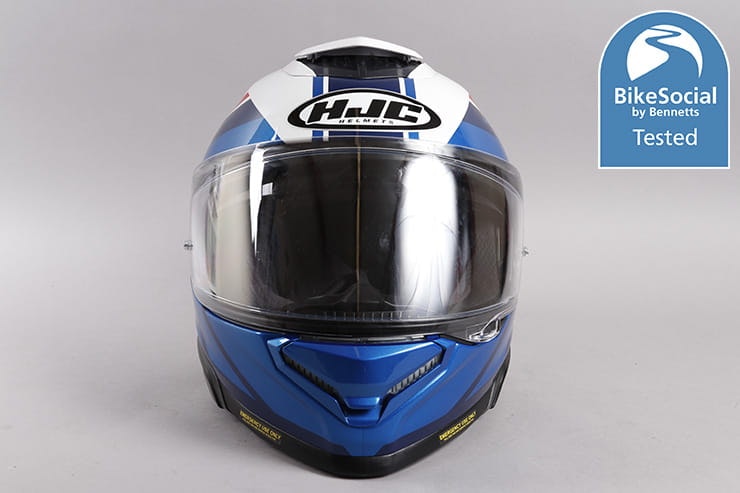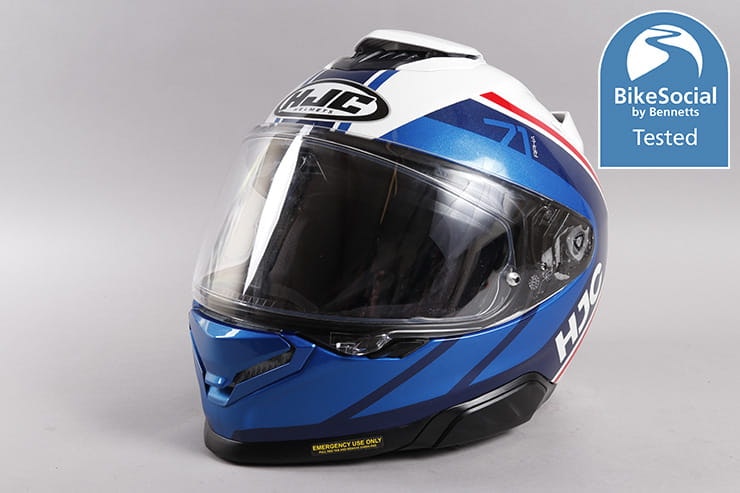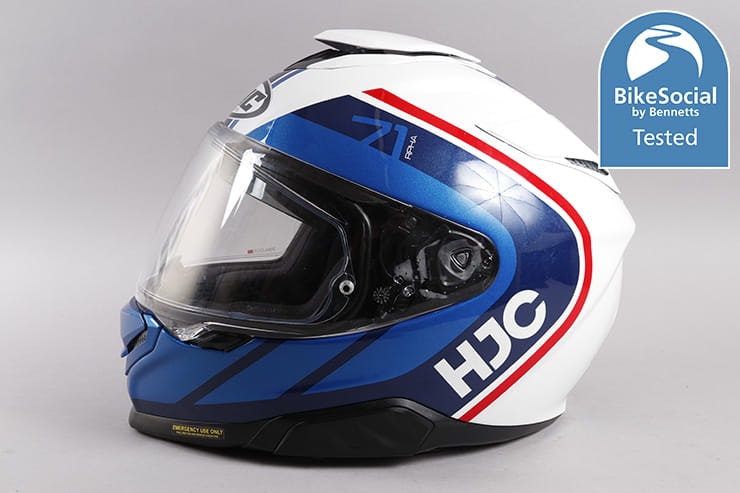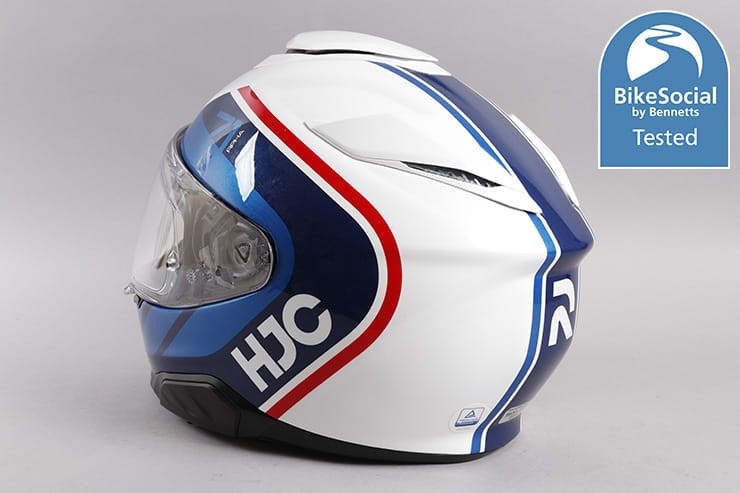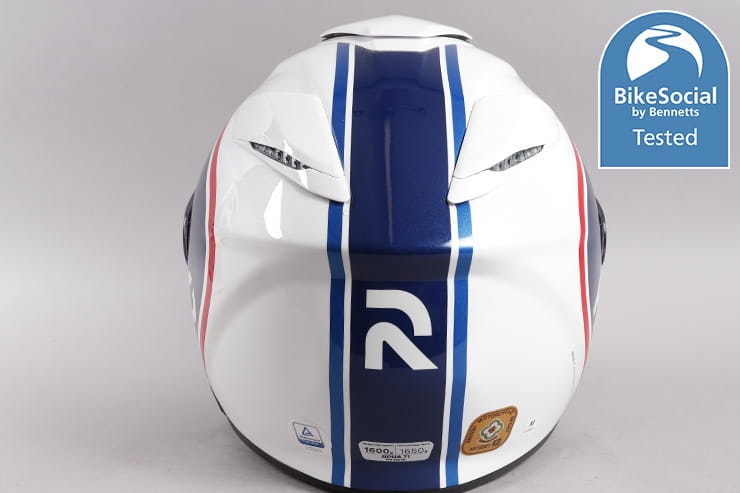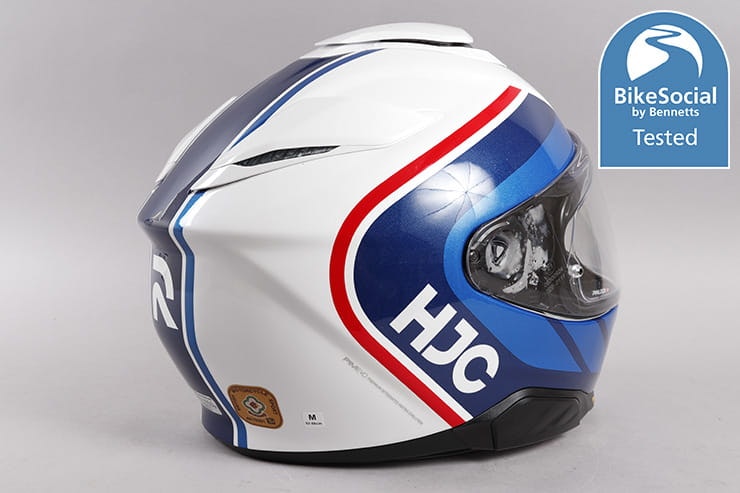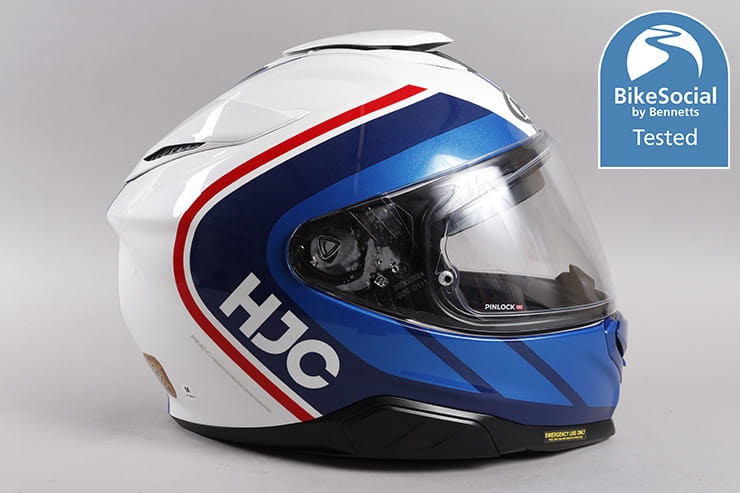HJC RPHA 71 review | Premium sport-touring helmet tested
By John Milbank
Consumer Editor of Bennetts BikeSocial
15.12.2023
Date reviewed: December 2023 | Tested by: John Milbank | Price: £399.99 | www.oxfordproducts.com
The HJC RPHA 71 on review here is the company’s premium sport-touring helmet, competing directly with the Arai Quantic and the Shoei GT-Air 3. That’s some pretty stiff competition, but it’s also £100 and £130 cheaper respectively than either of those in plain colours, and £150 and £200 cheaper in graphics. I’ve been using the HJC on a 2001 Honda VFR800 and a 2019 BMW R1250GS to find out if it’s a great value alternative…
Excellent value in this market
Powerful ventilation
Great build quality
Visor has only three useful stages
A bit more control on the vents would be good
Visor doesn’t lock easily
Outer shell
The RPHA 71 is arguably the most important helmet in HJC’s range as it can suit sportsbike riders, tourers and adventure riders. It’s for those who don’t need an all-out track-focussed lid.
This is an ECE22.06 helmet, which means it’s passed a far more stringent set of tests than the previous ECE22.05 required, putting it among the provably safest lids on the market. From January 2024, all production will stop on 22.05 lids, so 22.06 will become the norm over time. The RPHA 71 also comes with an ACU Gold sticker.
Starting at £399.99 for plain colours – including a lovely-looking new matt blue – graphics cost a very fair £50 more. I have the ‘Mapos MC21 White Red Blue’ on review, which I chose based on it looking good, and being very close to the Shoei GT-Air 3 I wanted to compare it to.
Finish is great, but look very closely and it can’t quite match its high-priced competitors
It looks excellent, with a lovely metallic shimmer all over, and very well applied graphics that, I think, look stunning. There is a difference though… not a £200 difference, granted, but compared to the Shoei in graphics at £649.99 there’s just a fraction less of a top-tier premium feel if you really want to nit-pick. There’s what looks like an overlap line on the front of the HJC, where the water-slide graphics have been applied, and I found a few very tiny imperfections in the lacquer. I really am nit-picking here, and I can almost hear the HJC PR team cursing me, but it’d be too easy to give a cursory look over and say ‘it’s just as good, well done HJC’.
Honestly though, it took five minutes of sitting at my desk under a bright light with both helmets side by side to pick holes like this and there’s no avoiding the fact that the RPHA 71 looks excellent, and easily compares to a helmet costing half as much again.
There’s also a carbon fibre version of the RPHA 71 costing £499.99 with no graphics, or £529.99 with them.
HJC helmets are made in three locations around the world, with the entry-level models being assembled in Vietnam, the mid-range in China and the premium RPHA models in Korea. This carbon-aramid fibre mix shell comes in three outer shell sizes covering XS to Medium with one, Large with another, and Extra Large to XXXL with the third, so someone with a small head won’t find themselves with a massive-looking, overweight lid.
Weight
On my scales, the HJC RPHA 71 weighs 1,668g, which is 10g lighter than the Shoei GT-Air 3, and 80g heavier than the Arai Quantic.
And that is irrelevant, in my opinion.
I’ve seen an increase in comments from people saying that helmets are too heavy now, but it used to be something of a trope that Arais were too weighty. Comparing some helmets in the hand you can sometimes see a difference, but in almost 30 years of riding I’ve yet to wear any that truly felt too heavy, for my neck at least. And I’m no body-builder.
Of all the ECE 22.06 helmets I’ve reviewed so far, they’re coming in at similar weights of around 1.5kg. What really matters is aerodynamics, and I’ve found no issues with the RPHA 71 either into the wind, or when turning my head for a shoulder-check.
Ventilation
The HJC RPHA 71 has a two-stage and closed chin vent that directs air noticeably up across the visor and to your brow. Sliding it down opens it, then more air can be allowed in by pressing the bottom of the slider, which tips it forward creating a larger gap. It’s a little unclear where you’ve set it when wearing gloves, and I didn’t notice much of a difference between the two settings, though it’ll depend very much on the size and shape of your bike’s screen.
On the top of the helmet is a large slider that effectively opens up a massive ram-air scoop. This is only open or closed, with no half setting. It gives great ventilation by feeding through three holes in the inner shell, but it’s worth noting that it creates a bit of a direct cold spot on the head. The benchmark of ventilation here has to be the Arai Quantic, which allows the air to flow over the head, rather than blast onto it. The Shoei GT-Air 3 has a cold ‘pressure’ point, but it’s not as obvious as the HJC. The option of a reduced setting here would have been appreciated.
The two rear exhaust vents are always open and draw air out through a total of four holes in the expanded polystyrene inner.
Like the GT-Air 3, in extreme conditions it is possible for some water to get into the always-open exhaust vents, and heavy rain at high speed can make its way past the top vent to a small extent.
Overall, the RPHA 71 gives good ventilation for hot weather, but lacks some of the control and ultimate sealing of its competitors, most notably the Arai, though that helmet’s lacking something the HJC and Shoei can both boast about…
Visor
The inclusion of a drop-down sunshield will be something that many riders demand, and it’s where the Arai loses out in this field.
The HJC’s drop-down shield has a clever mechanism that sees it drop then move forwards. This might help clear the nose for some people, though I didn’t notice it giving an increased coverage. You can set its forward and back position using a slider hidden under the intercom port, but due to its design, if you do need to adjust it to clear your nose, you might find it catches it on the way down.
Unlike some sunshields, the one fitted to the RPHA 71 clears my nose fine, and also gives very good coverage, with very little distracting light spill. However, the problem for HJC is that Shoei has done such a good job with the shield on the new GT-Air 3 (and the Neotec 3), that the gap above my nose is a little more noticeable on the HJC than on its competition.
The visor is extremely easy to remove and replace – one of the very best I’ve tried. Simply pull the tab forward on either side and the visor lifts clear, with the mechanism holding itself open ready to accept the visor back into place with a satisfying click as it locks again.
The visor seals well against rain, with channels in the sides allowing any water that collects along the top edge to flow away. This seal is maintained regardless of whether the visor’s fully locked down or not, which is good as it’s surprisingly awkward to lock it. To do so requires pushing firmly on the top edge of the visor, or slamming it down fast from fully open. Once locked, the thumb tab on the left flicks under a sprung catch, and to open it requires a deft swipe while pressing it in. That’s a fairly easy knack to get with the left hand, but still awkward with gloves on if trying to use your right hand while holding the clutch in. Personally, I prefer a central catch as it tends to be more accessible.
The old RPHA 70 had a central latch that was screwed into the visor. These had a reputation for breaking, but it’s really important to understand that the polycarbonate that’s used in visors is very susceptible to degradation if the wrong cleaners are used. This isn’t an excuse from HJC – it was cleaning product experts S100 that explained the issue to me, and pointed out how some cleaning agents were attacking the plastic around the screws, which acted as stress-risers to encourage cracking.
The RPHA 71 has a closed, then three stages of open visor
I do have an issue with the RPHA 71’s visor though… the cam-style mechanism provides a good, solid hold when fully open, but despite its ratchet system it falls from there to a stage about 55mm open. To be fair, settings between here and fully open seem unlikely to be used much, but there’s also an issue in that this is too high to have open and ride in, but below that the visor won’t stay open at anything beyond just cracked off locked. So, a small amount of additional airflow is possible with about 5mm of gap between the seal and the visor, but beyond that only the 55mm stage (or fully up), which puts the ridges in the bottom of the visor right in your eyeline, will stay open when riding. It’s a disappointing feature of this helmet that, for me at least, spoils an otherwise brilliant visor.
A Pinlock 120 anti-fog insert is included with the RPHA71, providing the highest level of protection against misting. It’s great to see that this also wraps right the way to the sides of the visor, keeping itself well out of your peripheral vision – something that Shoei didn’t do with its new helmet.
Lining
The anti-bacterial, moisture-wicking lining has quick-release cheek pads in case the helmet needs taking off more easily after an accident, and it’s simple to fully remove and replace for cleaning. It’s a quality lining that feels good against the skin.
Fastening
Like the Arai Quantic, the HJC RPHA 71 has a double-D fastener, which many sports riders prefer, but isn’t as easy to use – especially with gloves on – as the micrometric fastener found on the Shoei GT-Air 3.
It’s personal preference in many ways, but on a sport-touring lid, I’d prefer the micrometric.
Fit
The HJC does have a little more of a sporty fit – on me at least – than the Shoe GT-Air 3, meaning it hugs my head a touch more, so is perhaps better suited to very high speed use on track. It’s a lot more snug than the Arai, which doesn’t move around, but is a far more relaxed shape.
Having said that, fit is very subjective, and you should always try any helmet on for yourself. Personally, I find the Shoei and the Arai have a slightly more luxurious feel on the head, but the HJC is certainly not budget-feeling by any stretch. We’re all different, so try them on and see what you think…
I wear glasses, and find the HJC takes a fair bit more fiddling to get my specs’ arms over my ears. Once seated it’s fine and comfortable, and easier than the Bells I’ve tried, even those supposedly made for specs. It depends on the specs I’m wearing, but I do recommend you try the HJC before you buy if you use glasses.
I don’t think the neck of the HJC seals quite as well as it could, allowing some draft to get up and behind my ears, but that’s perhaps to do with the shape of my jaw. The design of the cheek pads means they have less of an edge than some others, so it might – for me – let a little more air in here. While the removable chin skirt does a good job, this is a helmet you’d probably want to wear a snood with during the winter months.
HJC RPHA 71 noise
I haven’t found the RPHA 71 to be particularly noisy, but as with every helmet you must wear earplugs at anything over about 40mph. It’s hard to say, even when swapping directly between lids, but for me I think the HJC is perhaps a fraction noisier than the Shoei or Arai. Or perhaps it’s just a different noise.
There are no undue whistles or buffets with the RPHA 71, and the noise levels will be affected massively by the bike you’re riding and the shape of your head. That draft I found behind my ears might affect my perception of the noise.
For more information on why earplugs are vital with any helmet, and advice on which are the best, click here.
Can I fit my own intercom to the HJC RPHA 71?
The RPHA 71 is designed to fit HJC’s £219.99 21B Bluetooth intercom, or the £349.99 50B Bluetooth and Mesh system (for much better group comms). These replace covers on the helmet to tuck neatly out of the way, but annoyingly HJC has made these pieces of plastic quite sculpted, so it’ll be harder to stick anything to them. While this style no doubt adds a more interesting look to the covers, it does feel a little like the arm-rests put on public benches to stop the homeless sleeping on them! Fortunately, there should be enough contact with a quality foam adhesive tape to hold – just check and take care. Alternatively, a comms unit could be fitted just below the visor aperture.
44mm diameter speakers fit into the plastic recesses fine, but the larger Cardo JBLs sit a little proud, so consider this if you’re worried they might press into your ears.
There’s usually a way to get universal comms into most lids, but the HJC RPHA 71 does throw up its own challenges.
Three alternatives to the HJC RPHA 71
A good sport-touring helmet should work great in all weathers, and be comfortable for a full day’s riding. Here are three others you might want to try, keeping in mind that the most important thing with a helmet is fit…
Shoei GT-Air 3 | From £529.99. This outstanding helmet does pretty much everything brilliantly, but it’s £130 to £200 more expensive than the HJC. Only you can decide if it’s worth that. Read the full Shoei GT-Air 3 review here.
Arai Quantic | From £499.99. The first ECE 22.06 helmet onto the market, and it’s got some of the best ventilation of any I’ve worn. An outstanding product, but it’s not got a drop-down sunshield, which for many will be a deal-breaker. Read the full review of the Arai Quantic here.
Schuberth S3 | From £429.99. We’ve not reviewed this Schuberth but it’s another premium touring full-face that’s worth considering. Check the fit carefully as I’ve not always got on well with this brand.
These are just three of many alternatives – you can find all the motorcycle helmets we’ve tested here and be sure to regularly check for the discounts available through Bikesocial membership.
HJC RPHA 71 review: Verdict
The HJC RPHA 71 is, perhaps, the slightly more sport-focussed of its competition. It’s got a much tighter fit than the Arai, and more aggressive ventilation than the Shoei. It also has a double-D fastener, which isn’t quite as convenient for touring riders.
There’s no denying that HJC has quite a battle on its hands in putting out a premium sport touring helmet that has to compete with two of the biggest benchmarks in this sector. But it brings something very significant to the fight: outstanding value. In graphics, it’s £150 less than the Arai Quantic (which doesn’t have a drop-down sunshield) and £200 less than the Shoei GT-Air 3.
The HJC RPHA 71 is a good lid that has its quirks, so I’d thoroughly recommend you try one on, but think carefully about what the extra money might get you with the competition.
If you’d like to chat about this article or anything else biking related, join us and thousands of other riders at the Bennetts BikeSocial Facebook page.
Best sport-touring helmet: Arai Quantic vs Shoei GT-Air 3 vs HJC RPHA 71 vs Shark Spartan GT
Four top-of-the-range full-face sport-touring helmets reviewed: Arai Quantic vs Shoei GT-Air 3 vs HJC RPHA 71 vs Shark Spartan GT Pro Carbon. They're all premium ECE 22.06 helmets, and in this video, we'll cover everything you need to know before deciding which is best for you.
